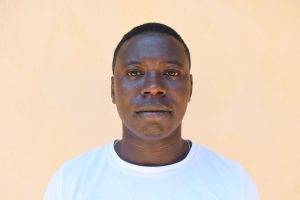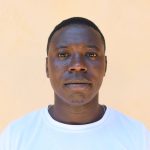The Nzakya Community, which includes 1,800 people, is in a semi-arid region of Southeastern Kenya. This corner of the world is very dry, and people struggle daily to access sufficient water to meet their needs.

A community member collects water from a scoop hole.
For water, community members can either go to a very distant well or use scoop holes in sandy river beds, but both options present serious concerns. The well is far away, so collecting water from there consumes much of their time. The scoop holes, are used by people and animals alike looking to quench their thirst so they are contaminated. No matter where they go to find water, the journey is arduous, and the journey home carrying heavy containers of water in the hot sun is even worse.
Field Officer Jefferson Mutie shared, "In this area, the rocky and uneven terrain poses significant challenges for water collection. The hard, impervious surface prevents water from easily soaking into the ground, causing it to flow quickly away. Additionally, the slopes and rugged landscape create rapid runoff, which makes it difficult to capture and store water effectively."
"Water sourced from a scoop hole often presents several sensory issues that raise concerns about its quality and safety. The appearance of the water is typically turbid, with a noticeable cloudiness due to suspended sediments and organic matter. The taste of the water from a scoop hole is often described as earthy or metallic, which can be unappealing and indicative of mineral content or microbial presence. These sensory characteristics not only make the water less palatable but also highlight the necessity for treatment before consumption to ensure safety and improve overall water quality," continued Jefferson.

Mutembi.
16-year-old Mutembei described the challenges he faces trying to collect sufficient water for his family.
"The scoop hole is always marked by the presence of many people who come to fetch water from the community. First, the trek is around 1.5 km (almost a mile away!), with poor terrain marked with rocks and dusty roads. Secondly, the process of collecting water isn't straightforward. The water level can be low, making it difficult to fill our containers quickly. We sometimes have to wait our turn as many others from the community are also there to fetch water. This can lead to long queues, especially during dry seasons when the water is scarce," Mutembei shared.

Mutembi.
"I am worried about the water from the scoop hole, as it is open to contamination, and my parents prefer it to the shallow well one as it is very far from us. The scoop hole water also poses waterborne diseases that can even be a lifetime one, and others can lead to poor school performance, which is my greatest fear," he continued.
Water scarcity also causes conflict among community members.
Mutembi said, "At the scoop hole water source, we have no defined order for members to fetch water. Many times, it's always the fight for survival. I was once bullied by the big community members, who made me feel bad by taking my spot in fetching water. I even cried, but no one could help me."
Fear and frustration taint Mutembei's every day.
"Most days, I would leave home in the morning [for school] with a message that I should come home very early to fetch water. This sentiment used to run in my head throughout the day; even during classes. My concentration would go down. Having less time to do my homework after school always gave me and my teachers a hard time, as we'd be quarreling, and this made my grades drop."
Implementing a sand dam in conjunction with a well will provide Mutembi with an accessible water source. He won't have to walk miles every day to collect water. With his water needs more easily met, he will work hard in school and play with his friends—two crucial aspects of childhood!
"The new water point will provide clean water, promising me health security, and also, the distance will be significantly shorter. The terrain is much better, making me feel safe while fetching water. I would use that time to help my mother work on our farm and also get time to play with my friends," he added.

Mutembei at the well, almost a mile away from home.
Solving the water crisis in this community will require a multifaceted system that will work together to create a sustainable water source that will serve this community for years to come.
Steps Toward a Solution
Our technical experts worked with the local community to identify the most effective solution to their water crisis. Together, they decided to construct a sand dam and a protected dug well.
Sand Dam
Sand dams are sought-after, climate-smart, and lasting water solutions, providing hope and resilience to communities in arid Southeastern Kenya. Think of them like giant sandboxes constructed in seasonal rivers that would typically quickly dry up after the rainy season. Instead of holding water like traditional dams, they collect sand and silt.
When infrequent rains do come, these dams catch a percentage of the river's flow, letting most of the water continue downstream to other communities. But here's the magic: the sand they collect acts like a natural filter, holding onto water long after the river's gone dry. Then, wells are constructed nearby, creating a reliable water source even during the driest times.
And the benefits don't stop there! In communities impacted by climate change, sand dams replenish groundwater and prevent soil erosion. Even during severe droughts, the consistent water supply from these sand dams allows farmers to thrive, giving way for enough food not only for their families but also to sell in local markets.
The most remarkable aspect of sand dams is how they involve the local community every step of the way, giving them a sense of ownership and pride in solving their own water shortage and managing their own water resources.
This sand dam will be connected to a protected dug well to make the water more accessible.
What Makes This Project Unique
In sand dams with an adequate supply, a submersible pump can be installed to tap into the underground water and pipe it into public piped water kiosks. These kiosks expand the reach of this water infrastructure, allowing more people to access clean, reliable water closer to home. The size and location of this sand dam give us hope that it will hold a lot of water when it matures - possibly even enough to pipe water to the community in the future. In anticipation of that, we are installing some extra infrastructure that would enable the future development of solar-powered water kiosks.
Community Education & Ownership
Hygiene and sanitation training are integral to our water projects. Training is tailored to each community's specific needs and includes key topics such as proper water handling, improved hygiene practices, disease transmission prevention, and care of the new water point. Safe water and improved hygiene habits foster a healthier future for everyone in the community. Encouraged and supported by the guidance of our team, a water user committee representative of the community's diverse members assumes responsibility for maintaining the water point, often gathering fees to ensure its upkeep.

 Sand Dam
Sand Dam
 Rehabilitation Project
Rehabilitation Project



















